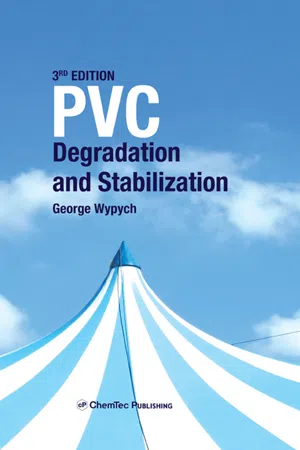
- 500 pages
- English
- ePUB (mobile friendly)
- Available on iOS & Android
PVC Degradation and Stabilization
About This Book
PVC stabilization, the most important aspect of formulation and performance of this polymer, is discussed in details. This book contains all information required to design successful stabilization formula for any product made out of PVC.
Separate chapters review information on chemical structure, PVC manufacturing technology, morphology, degradation by thermal energy, UV, gamma, other forms of radiation, mechanodegradation, and chemical degradation. The chapter on analytical methods used in studying of degradative and stabilization processes helps in establishing system of checking results of stabilization with different stabilizing systems. Stabilization and stabilizers are discussed in full detail in the most important chapter of this book. The final chapter contains information on the effects of PVC and its additives on health, safety and environment.
This book contains analysis of all essential papers and patents published until recently on the above subject. It either locates the answers to relevant questions and offers solutions or gives references in which such answers can be found.
PVC Degradation and Stabilization is must to have for chemists, engineers, scientists, university teachers and students, designers, material scientists, environmental chemists, and lawyers who work with polyvinyl chloride and its additives or have any interest in these products. This book is the one authoritative source on the subject.
- A practical and up-to-date reference guide for engineers and scientists designing with PVC
- Covers thermal, UV, gamma radiation, chemical, and other forms of degradation
- Includes a critical discussion of the sustainability issues faced by PVC and its additives, as well as health and safety concerns
Frequently asked questions
Information
CHEMICAL STRUCTURE OF PVC
1.1 REPEAT STRUCTURES AND THEIR BASIC ORGANIC CHEMISTRY
| Bond | Bond length, pm | Atomic radius, pm | Bond dipole moment, Debye |
| C–C | 154 | C=77 | 0 |
| C–H | 109 | H=37 | 0.30 |
| C–Cl | 177 | Cl=100 | 1.56 |
Table of contents
- Cover image
- Title page
- Table of Contents
- Copyright
- Chapter 1: CHEMICAL STRUCTURE OF PVC
- Chapter 2: PVC MANUFACTURE TECHNOLOGY
- Chapter 3: PVC MORPHOLOGY
- Chapter 4: PRINCIPLES OF THERMAL DEGRADATION
- Chapter 5: PRINCIPLES OF UV DEGRADATION
- Chapter 6: PRINCIPLES OF DEGRADATION BY γ-RADIATION
- Chapter 7: DEGRADATION BY OTHER FORMS OF RADIATION
- Chapter 8: MECHANODEGRADATION
- Chapter 9: CHEMICAL DEGRADATION
- Chapter 10: ANALYTICAL METHODS
- Chapter 11: PRINCIPLES OF STABILIZATION
- Chapter 12: HEALTH & SAFETY AND ENVIRONMENTAL IMPACT
- INDEX
